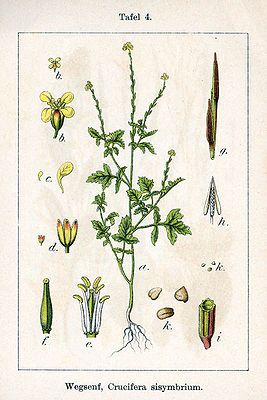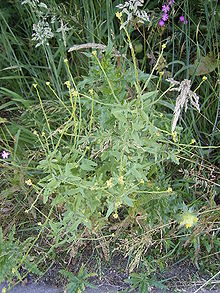Way rocket
| Way rocket | ||||||||||||
|---|---|---|---|---|---|---|---|---|---|---|---|---|

Rocket ( Sisymbrium officinale ), illustration |
||||||||||||
| Systematics | ||||||||||||
|
||||||||||||
| Scientific name | ||||||||||||
| Sisymbrium officinale | ||||||||||||
| L. |
The hedge mustard ( Sisymbrium officinale ), also real rocket or Ordinary rocket called, is a species of the genus rauks ( Sisymbrium ) within the family of the cabbage family (Brassicaceae). It is widespread in Eurasia and North Africa. The road rocket is common in Europe and grows on roadsides and as a " weed " in fields and gardens.
description
Vegetative characteristics
The rocket is an annual herbaceous plant that reaches heights of 30 to 70 centimeters. The rocket grows upright with sparsely protruding, but arching upward side branches.
In a basal leaf rosette there are pinnately lobed leaves with a large end section. Further up the leaves become narrower and smaller. The leaf margins are serrated.
Generative characteristics
The flowering period lasts from May to early summer until August . The initially umbrella-clustered later cluster-like inflorescences are located on the branched stems .
The relatively small, hermaphrodite flowers are four-fold. There are four green sepals . The four yellow petals are 2 to 4 millimeters long. There are six stamens .
The narrow, hairy pods are 8 to 20 millimeters long and are pressed against the stem . The fruit stalk is 2 to 3 millimeters long and almost as thick as the pods. The seeds have the dimensions: 1 to 1.3 × 0.5 to 0.6 millimeters.
Chromosome set and ingredients
There is diploidy with a chromosome number of 2n = 14.
The hedge mustard contains tannic acid , vitamin C .
ecology
The rocket is a mesomorphic therophyte that is annual in summer or winter. The rocket has roots up to 20.5 centimeters deep. It is considered a nitrogen indicator .
The inconspicuous flowers are ecologically "nectar-bearing disc flowers". The pollination is done by insects or by self-pollination .
The fruits are wind spreaders. The seeds remain in the fruit for a long time and are often only carried away with the whole, bulky plant as soon as it has died. Fruit ripening is from July to October. The plant is a winter stand. The seeds are light germs .
Common names
There are many German-language trivial names for this species , for example Weg-Rauke, Echte Rauke, Ordinary Rauke, Raukensenf, Wegsenf or Sängerkraut.
Since the hedge mustard a certain resemblance to the genuine verbena ( Verbena officinalis has), it is also known as Yellow verbena.
Occurrence
The main distribution area after Oberdorfer is Eurasian (species of the large deciduous forest area that extends through Eurasia). It is also originally found in North Africa. In other African countries it is a neophyte , as well as in North and South America, Hawaii, Mauritius, New Zealand, Australia and Macaronesia.
The rocket grows best on nutrient-rich soils in warm locations. You can find them on paths, as a garden “weed”, on rubble , fallow land , dams and on banks. It is a character species of the Sisymbrion association, but also occurs in plant communities of the Arction and the Polygonion avicularis. In the Allgäu Alps it rises near the mountain station of the Kanzelwandbahn up to an altitude of 1920 meters.
use
According to Haeupler & Muer 2000, the rocket is indicated as poisonous for certain animals.
In earlier times the dead plants were used as brooms.
Use as a spice plant
You can also use the young leaves and seeds as a kitchen spice.
The seeds of the rocket can be used as a spice. They have a tangy, mustard-like aroma. The fresh, chopped leaves give dishes a piquant, cress-like taste. When dried, they can be pulverized and used like mustard powder. The collection time is from June to September.
Use as a medicinal plant
In folk medicine , the rocket was used as a tea . The rocket was also known as singer's herb because the tea was used against inflammation of the vocal cords. Rocket is used in herbal medicine as a remedy for hoarseness after colds. As a medicinal plant, the ground rock is almost unknown today.
Sources and further information
The article is mainly based on the following documents:
- Ruprecht Düll , Herfried Kutzelnigg : Pocket dictionary of plants in Germany and neighboring countries. The most common Central European species in portrait. 7th, corrected and enlarged edition. Quelle & Meyer, Wiebelsheim 2011, ISBN 978-3-494-01424-1 .
Individual evidence
- ↑ a b Sisymbrium officinale (L.) Scop., Rauke. In: FloraWeb.de.
- ↑ a b Erich Oberdorfer : Plant-sociological excursion flora for Germany and neighboring areas. 8th edition. Page 474. Stuttgart, Verlag Eugen Ulmer, 2001, ISBN 3-8001-3131-5 .
- ↑ Tai-yien Cheo, Lianli Lu, Guang Yang, Ihsan Al-Shehbaz, Vladimir Dorofeev: Brassicaceae. : Sisymbrium officinale (Linnaeus) Scopoli , p. 180 - online with the same text as the printed work , In: Wu Zheng-yi, Peter H. Raven (ed.): Flora of China. Volume 8: Brassicaceae through Saxifragaceae , Science Press and Missouri Botanical Garden Press, Beijing and St. Louis, 2001, ISBN 0-915279-93-2 .
- ↑ a b Gunter Steinbach (Ed.), Bruno P. Kremer u. a .: wildflowers. Recognize & determine. Mosaik, Munich 2001, ISBN 3-576-11456-4 , p. 70.
- ^ Sisymbrium officinale in the Germplasm Resources Information Network (GRIN), USDA , ARS , National Genetic Resources Program. National Germplasm Resources Laboratory, Beltsville, Maryland. Retrieved August 1, 2017.
- ↑ Erhard Dörr, Wolfgang Lippert : Flora of the Allgäu and its surroundings. Volume 1, IHW-Verlag, Eching near Munich, 2001, ISBN 3-930167-50-6 . Page 572.
- ↑ Henning Haeupler , Thomas Muer: picture atlas of the fern and flowering plants of Germany (= The fern and flowering plants of Germany. Volume 2). Published by the Federal Agency for Nature Conservation. Ulmer, Stuttgart 2000, ISBN 3-8001-3364-4 .
- ↑ Oskar Sebald : Guide through nature. Wild plants of Central Europe. ADAC Verlag, Munich 1989, ISBN 3-87003-352-5 .
Web links
- Profile and distribution map for Bavaria . In: Botanical Information Hub of Bavaria .
- Sisymbrium officinale (L.) Scop. In: Info Flora , the national data and information center for Swiss flora . Retrieved October 29, 2015.
- Distribution in the northern hemisphere.
- Thomas Meyer: Data sheet with identification key and photos at Flora-de: Flora von Deutschland (old name of the website: Flowers in Swabia ).
- Heilkräuter.de - Rocket as a medicinal plant.
- Characteristics.



